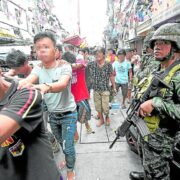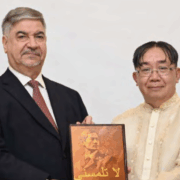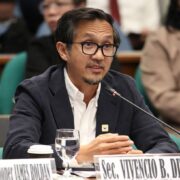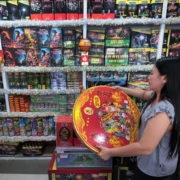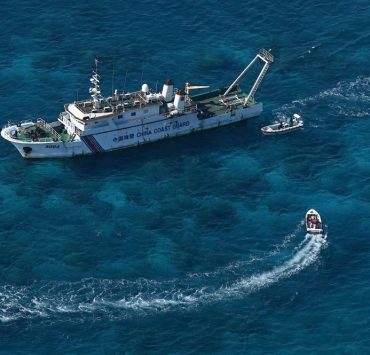Helen Calista Wilson: Wanderlustful spinster
By all counts, Helen Calista Wilson was an extraordinary woman. In a time when women were born and raised to get married, stay home, and raise a family, Helen remained single and indulged in wanderlust and adventure. She spent five years in the Philippines and 14 in Russia. In 1929, she published “Vagabonding at Fifty” documenting how she and her lifelong partner, Elsie Reed Mitchell, covered 7,600 miles from Siberia to Turkestan. Then as now, these are not tourist destinations. Traveling there is not for the faint of heart, but these American spinsters journeyed without escort, equipped with: “a Boy Scout hatchet, drinking cups, sleeve less sweaters, knickerbockers, an oiled sheet [for a tent], a fox terrier [for luck].” Time magazine reported that, “No man molested them—neither bandit, desperado, nor escaped Siberian convict. They lived on the land, eating black bread and water, berries, mushrooms, honey, milk.”
A pity that all she published on the Philippines was a 48-page pamphlet that did not even carry her name. “A Massachusetts Woman in the Philippines: Notes and Observations” was copyrighted under the name of a prominent anti-imperialist, Fiske Warren, whose name appears in library catalogs instead of Helen Calista Wilson.
Helen arrived in Nagasaki from the United States in March 1903, and met with a certain Señor Castro, his Portuguese wife, daughters, and some of their Filipino friends. Here, she was told about a plan to bring Emilio Aguinaldo on a lecture tour in the US sponsored by the anti-imperialist league. She heard about Apolinario Mabini and Artemio Ricarte released from their Guam exile in February, but only allowed to return to the Philippines after taking the oath of allegiance to the US.
Upon arrival in Hong Kong on March 17, 1903, she set out for the home of Jose Ma. Basa on Remedios Terrace. It was a difficult quest: on foot, in a rickshaw, and even carried on a sedan chair because Chinese was not in her skill set. Afterwards, she met with various members of the Hong Kong Junta and important players like Galicano Apacible, Mariano Ponce, Vicente Ilustre, and Felipe Buencamino who she described as: ”a fluent talker, and seems by far the most brilliant and keen of those whom I have seen, and he appears to be quite aware of this fact … He has five children, all girls, and it is certainly one of the man’s finest traits that he is deeply interested in their education.”
Artemio Ricarte “Vibora” (the Viper) she described as: “an unassuming sort of person, and, like the knife grader, seems quite unaware that he has a story to tell … Ricarte is a young man with a soldierly bearing, and a frank, open, boyish face, and apparently of an unconquerably cheerful and courageous disposition. He is not, as so far as I could judge, as highly educated as some of the members of the Junta, and is not quite so fluent a talker, but he is keen and thoroughly intelligent.”
Unlike Mabini, who took the oath to die in his homeland, Ricarte refused to swear allegiance to the US and was transported to Hong Kong. During his exile, his property was confiscated, his house burned, and his wife and two daughters abandoned and were destitute. Furthermore, his wife’s 13-year-old brother was “desaparecido.” Ricarte recalled the night of Feb. 4, when the first shot of the Philippine-American War was fired. Ricarte was not at his post at the time, being at a ball in Malolos. To clear things up, Ricarte sought a conference with enemy general Arthur MacArthur Jr., father of Douglas MacArthur, to find out what really happened, and emphasized that the Filipinos did not provoke hostilities. MacArthur declined, prompting Ricarte to recount with some bitterness that: “even then, [MacArthur] called us insurrectos.”
Helen was a bit of a novelty to the Filipinos who did not know what to make of “a strong-minded woman traveling around the world alone.” She does not appear in any of the papers or reminiscences of the Filipinos she met in Hong Kong and the Philippines. I do not know if she met Mabini before his death on May 13, 1903, but she left us with a moving account of Mabini’s funeral that was unusual, not just for the immense crowd that accompanied the “Sublime Paralytic” to what is now the Chinese cemetery.
Mabini died during a cholera epidemic yet people defied US colonial health ordinances to pay their respects: “… without jostling or disorder, came the Filipino people, thousands of them, many of them on foot; and, as far as the eye could reach, carriages and more carriages filling the wide avenue [of Sampaloc] from sidewalk to sidewalk … there was something strangely and deeply impressive about the democratic simplicity of this great orderly silent gathering, rich and poor together following in the heat of the street.”
When Helen Calista Wilson’s papers turn up someday, these will add more Her-story to Philippine history.
Comments are welcome at aocampo@ateneo.edu
Ambeth is a Public Historian whose research covers 19th century Philippines: its art, culture, and the people who figure in the birth of the nation. Professor and former Chair, Department of History, Ateneo de Manila University, he writes a widely-read editorial page column for the Philippine Daily Inquirer, and has published over 30 books—the most recent being: Martial Law: Looking Back 15 (Anvil, 2021) and Yaman: History and Heritage in Philippine Money (Bangko Sentral ng Pilipinas, 2021).




